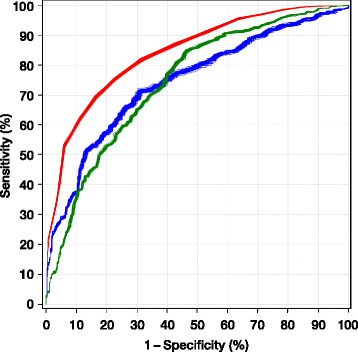Early predictors of poor outcome after out-of-hospital cardiac arrest
- PMID: 28410590
- PMCID: PMC5391587
- DOI: 10.1186/s13054-017-1677-2
Early predictors of poor outcome after out-of-hospital cardiac arrest
Abstract
Background: Early identification of predictors for a poor long-term outcome in patients who survive the initial phase of out-of-hospital cardiac arrest (OHCA) may facilitate future clinical research, the process of care and information provided to relatives. The aim of this study was to determine the association between variables available from the patient's history and status at intensive care admission with outcome in unconscious survivors of OHCA.
Methods: Using the cohort of the Target Temperature Management trial, we performed a post hoc analysis of 933 unconscious patients with OHCA of presumed cardiac cause who had a complete 6-month follow-up. Outcomes were survival and neurological function as defined by the Cerebral Performance Category (CPC) scale at 6 months after OHCA. After multiple imputations to compensate for missing data, backward stepwise multivariable logistic regression was applied to identify factors independently predictive of a poor outcome (CPC 3-5). On the basis of these factors, a risk score for poor outcome was constructed.
Results: We identified ten independent predictors of a poor outcome: older age, cardiac arrest occurring at home, initial rhythm other than ventricular fibrillation/tachycardia, longer duration of no flow, longer duration of low flow, administration of adrenaline, bilateral absence of corneal and pupillary reflexes, Glasgow Coma Scale motor response 1, lower pH and a partial pressure of carbon dioxide in arterial blood value lower than 4.5 kPa at hospital admission. A risk score based on the impact of each of these variables in the model yielded a median (range) AUC of 0.842 (0.840-0.845) and good calibration. Internal validation of the score using bootstrapping yielded a median (range) AUC corrected for optimism of 0.818 (0.816-0.821).
Conclusions: Among variables available at admission to intensive care, we identified ten independent predictors of a poor outcome at 6 months for initial survivors of OHCA. They reflected pre-hospital circumstances (six variables) and patient status on hospital admission (four variables). By using a simple and easy-to-use risk scoring system based on these variables, patients at high risk for a poor outcome after OHCA may be identified early.
Keywords: Intensive care; Out-of-hospital cardiac arrest; Prognosis; Risk score.
Figures

References
-
- Müllner M, Sterz F, Domanovits H, Behringer W, Binder M, Laggner AN. The association between blood lactate concentration on admission, duration of cardiac arrest, and functional neurological recovery in patients resuscitated from ventricular fibrillation. Intensive Care Med. 1997;23(11):1138–43. doi: 10.1007/s001340050470. - DOI - PubMed
MeSH terms
LinkOut - more resources
Full Text Sources
Other Literature Sources

